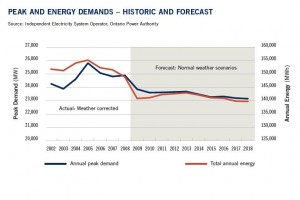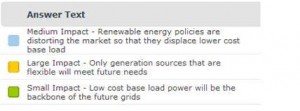Lower demand and more renewables – is Surplus Base Load Generation here to stay?
At that time, I started a poll asking about the future of baseload power. Since then, the IESO in Ontario has published its latest Reliability Outlook. The numbers are striking. Demand was down 6.4% in 2009. The following graph shows that demand is not expected to reach pre-economic crisis peaks even by 2018.
As of result the province continues to experience Surplus Baseload Generation (SBG). Forecasts of SBG are now made daily. With the growth of renewable generation SBG is expected to continue into the future. This will certainly impact any decision for building new nuclear, as nuclear plants are most suited to providing long term stable baseload power and energy.
The commitment to renewable energy continues to grow. Wind generation in Ontario rose by more than 60 per cent in 2009 over the previous year, to 2.3 TWh. Ontario has implemented the Green Energy Act, arguably making it one of the “greenest” jurisdictions in North America. Just this past week, government announced a $7 Billion deal for 2,500 MW of new renewable generation from a Korean consortium led by Samsung C&T. The deal includes the implementation of new manufacturing in the province for both wind and solar components.
While the above chart does not show baseload, with 1,000 MW of wind on the system and 11,500 MW of nuclear, this spring, Ontario started to experience SBG on a weekly basis. This resulted in nuclear unit reductions on 54 days, nuclear shutdowns on five days and water spillage at hydro facilities on 33 days. In the Reliability Outlook the projection is for 1600 MW of wind by 2013. With the Samsung deal and other FIT program renewables, we could be approaching 4,000 MW of wind and solar in the coming years while the overall demand is not expected to increase dramatically. Therefore, the baseload requirements will be further squeezed from the bottom as renewable generation has priority to the system when available. In other words, both renewables and nuclear are “non flexible” load i.e. not readily dispatchable. Clearly SBG will be an ongoing issue.
And now, for the results of my earlier poll. Although the number of votes was somewhat modest, the trend was clear.
While the comments suggested that baseload is important, only 10% of respondents thought that renewables will have a small impact on the use of baseload. The most votes were for “Medium Impact” as it seems to be recognized that renewables are here to stay and that the nature of electric grids are going to be changed forever.







6 Comments
Norman Rubin · February 12, 2010 at 4:17 pm
This is important stuff! Sometimes I don’t think there are 12 of us who understand this issue — or the fact that wind and nuclear are trying to “eat the same lunch”!
solarpower · October 6, 2010 at 9:08 am
We were referred to come here to have a glance because of the info is great, I’m thankful I did, appreciate it guys regarding having this sort of suitable facts on the topic, I’ll encourage other folks to come here too, continue the great job.
Wind Power Generators · November 23, 2010 at 8:28 pm
I found this blog while searching for Wind Power Generators today. Interesting.
Wind Power Generators · November 24, 2010 at 2:20 am
I came across this post, Lower demand and more renewables – is Surplus Base Load Generation here to stay? « mzconsultinginc.com while I was searching for Wind Power Generators and thought it was interesting and a little unique.
sunpowerport · January 1, 2011 at 6:42 am
I agree solarpower. I think it is the best article I have read in this website! Great job for the author!
“The Green Energy Act needs to be scrapped” « NorthGowerWindTurbines · September 13, 2010 at 11:52 am
[…] Ontario’s Independent Electricity System Operator is now predicting that the additional power from wind and solar generators will make those expensive and wasteful episodes of surplus baseload generation more frequent for years to come. It is expected that, to cope with the more frequent periods of low demand/excess electricity, wind and solar power generators will be taken off-line from time to time. However, consumers will still have to pay the wind and solar companies for the power they do not deliver while off-line. In a nutshell: McGuinty’s Green Energy Act will leave consumers paying the US even more to ditch excess electricity while simultaneously encouraging the construction of even more solar and wind power generators whose owners will be paid not to generate electricity during the periods of excess electricity that their wind and solar generators cause. […]
Comments are closed.